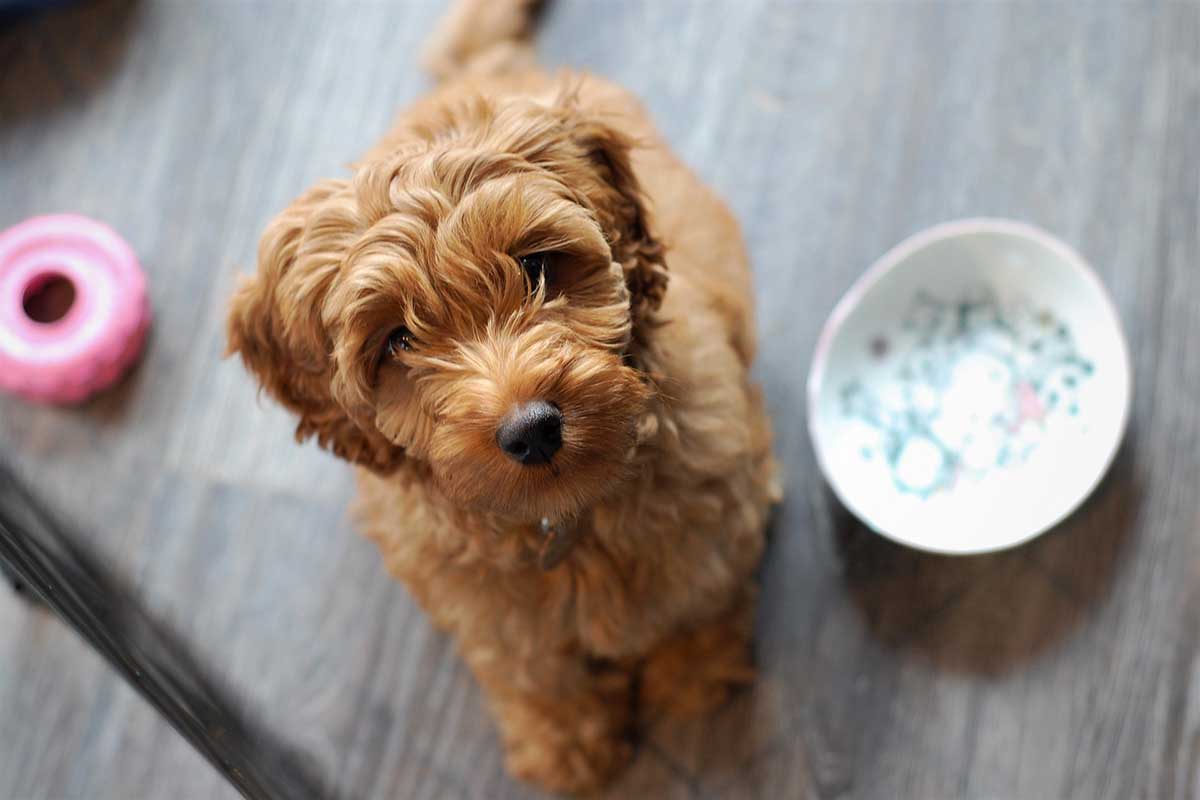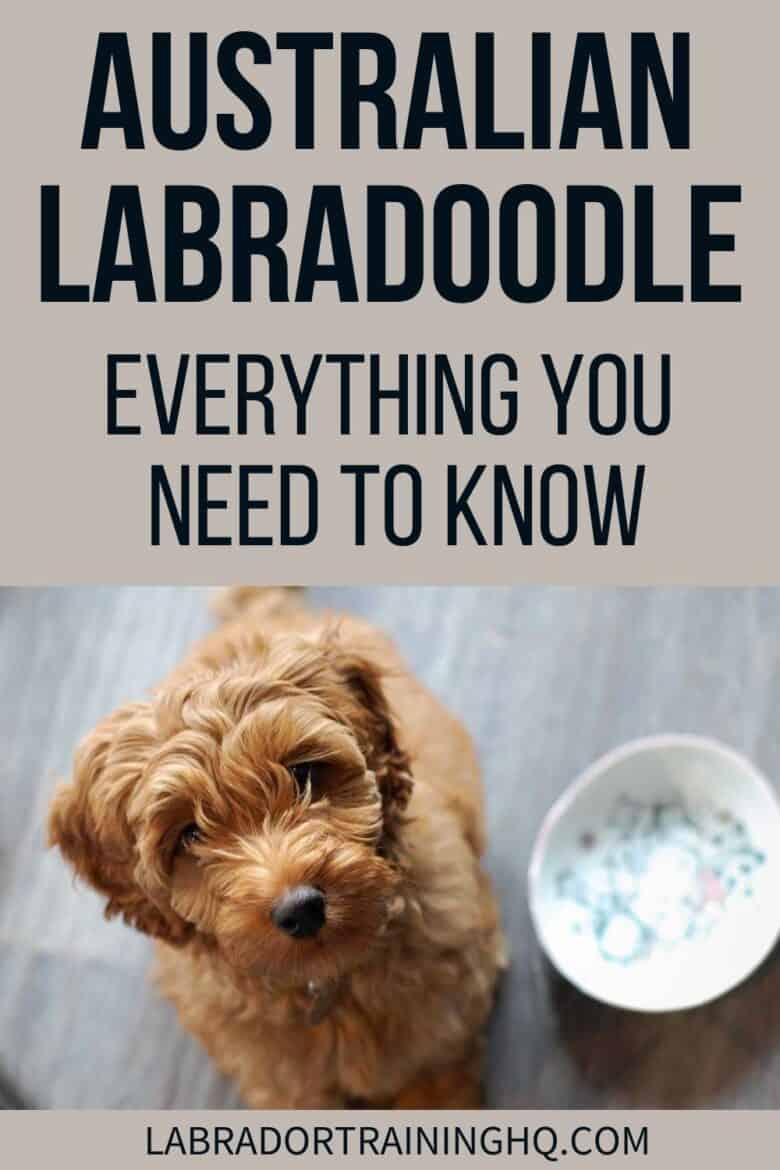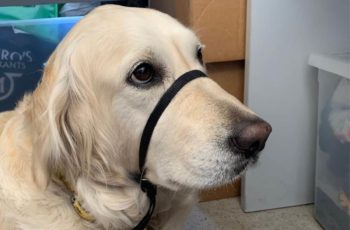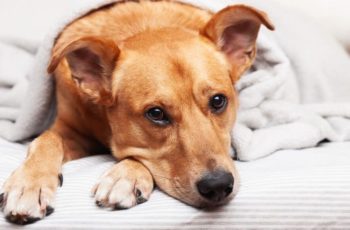This post may contain affiliate links. We may earn money or products from the companies mentioned in this post.
The Australian labradoodle is a cute-looking, friendly, and extremely smart mixed breed dog.
Developed by crossing the Labrador retriever, poodle, and Cocker Spaniel dog breeds, this designer hybrid was originally created as an allergy-friendly guide dog.
Not to be confused with a lively labradoodle, the Australian labradoodle can make an ideal service dog or a low-shedding family companion.
If you are looking for an allergy-friendly service animal or an active canine companion for your kids, you’re in the right place!

In this article, I’ll tell you everything you need to know about Australian Labradoodle and whether this is the right mix for you. Keep on reading to find out!
Contents & Quick Navigation
Aussie Labradoodle Overview
- Size – 14 to 24 inches tall, and weighs between 15 and 65 pounds
- Coat – Any length, wavy, straight, or curly, single coat, color varies
- Shedding – Minimal shedding
- Lifespan – 12 to 15 years
- Temperament – Highly intelligent, friendly, energetic, and joyful
- Trainable – Highly trainable, but can become bored if not mentally stimulated
- Activity – Very active (needs around one hour of activity every day)
- Best For – Families and people with active lifestyles and time to interact with them
What Is An Australian Doodle?
Despite common beliefs, the Aussie labradoodle isn’t simply a labradoodle that was born and bred in Australia! In fact, there are more differences between an Australian labradoodle and a labradoodle than it meets the eye.
The Australian labradoodle, also known as Australian doodle, or Aussie labradoodle was developed by crossing Labrador retriever, Poodle, and Cocker Spaniel dog breeds.
However, unlike other “doodle” breeds, the Aussie labradoodle has been developed over the years, and most are multigenerational. This means that breeders now develop Australian labradoodle puppies by breeding two Aussie labradoodle dogs.
Australian Labradoodle Appearance
Unlike other mixed-breeds, the Aussie labradoodle has been carefully developed since the 1980s with a special focus on temperament, coat quality, and soundness of the breed. This means that there are no surprises when it comes to the looks and temperament of this breed.
In terms of general appearance, expect your doodle to look like an adorable plush teddy bear with big and round expressive eyes.
Although predicting their looks isn’t as hard as guessing the lottery, Australian labradoodles may still surprise you, mainly when it comes to their size.
Size
The thing most people don’t know is that this breed comes in several different sizes! Most Aussie labradoodles are between 14 and 24 inches tall and weigh between 15 and 65 pounds.
At this phase in the breed’s development, the Australian doodle comes in three different sizes:
- Miniature: Between 14 and 16 inches high at the shoulders and weighing between 15 and 25 pounds.
- Medium: Between 17 and 20 inches tall and weighing from 30 to 45 pounds. Ideally, females should be 17 to 19 inches tall, and male dogs should be between 18 and 20 inches high.
- Standard: Between 21 and 24 inches tall at the shoulders and should weigh between 50 and 65 pounds.
If you live in an apartment or don’t have access to a fenced yard, a miniature or medium Aussie labradoodle can make an ideal pet as long as you can keep them exercised.
Color
These gorgeous dogs can come in a variety of different coat colors and patterns. Depending on their genetic makeup, Australian labradoodles can come in several shades of brown, ranging from an almost-white caramel ice to deep chocolate brown.
It’s not uncommon to find cream, apricot, red, gold, black, silver, blue, or chalk Aussie labradoodles. The most commonly seen patterns in this breed are parti-colored, tuxedo, sable, and phantom, but solid-colored pups are also common.
Coat
Aussie labradoodles can have two coat types – either a fleece textured or wool textured coat. Regardless of the type, the coat can be wavy, straight, or form curls but shouldn’t be too fluffy or too thick.
The fleece-textured coat is very soft and can either be straight, wavy, or have spiraling curls. As you can imagine, a wool-textured coat feels like wool and is usually curly.
The coat is definitely the trait that adds to the Australian labradoodle’s appeal! It’s non-shedding and won’t make you sneeze if you suffer from allergies, and it also makes this dog look like a cute teddy bear.
Aussie Labradoodle Character
Aussie labradoodles are very intelligent, people-oriented, loving, and joyful canines. They can also be very comical to have around and are known to entertain their owners with silly antics.
Lively and friendly, this breed gets along well with children and can be a great family pet and companion.
In fact, when carefully bred for temperament, Australian labradoodles are one of the best service dog breeds thanks to their intuitive, clever, and outgoing nature. This breed inherited the high intelligence of a poodle, meaning they are quick to learn new commands and tricks and are highly trainable.
Owning such a smart dog isn’t always as good as it sounds, and you’ll need to find creative ways to keep your pup’s mind busy, in a good way. Otherwise, your Aussie labradoodle will soon become bored and might try to have some fun by chewing your shoes or furniture.
People-loving and energetic, this breed loves to spend time with its family and will happily play or cuddle with you for hours on end. However, they don’t like to be left at home alone or in a crate for an extended period of time.
If you spend most of your days away from home, the Australian doodle isn’t the right dog for you. They crave companionship and are the happiest when surrounded by their human families.
Activity Level
This energetic, fun, and agile dog is best suited for active people or families that spend most of their time outdoors. While not as energetic as Shepradors or some other Lab mixes, this breed likes to stay active and needs regular exercise.
Ideally, you should walk your dog at least twice a day, and if possible, take them hiking or swimming every now and then. Besides taking them for daily walks, you will also need to play with your dog and find ways to keep them entertained and mentally stimulated.
Caring For An Australian Labradoodle
Although a fairly low-maintenance breed, the Australian doodle still needs proper care and attention to stay happy and thrive. Like with any other dog, caring for an Aussie labradoodle will require a bit of time and effort on your part.
To meet every one of your dog’s needs, you should come up with a regular care routine as soon as you bring your puppy home. Here are a few things you should pay attention to!
Exercise
Being related to both the poodle and Labrador retriever dog breeds, Australian labradoodles are naturally active dogs. Ideally, your Aussie labradoodle will need around one hour of exercise every day.
Two longer walks or several shorter walks will give your dog a chance to relieve themselves and burn some excess energy. However, your dog will be extremely pleased if you also add at least 30 minutes of play to your daily routine.
They love all sorts of games and excel at agility sports, so you can set up a course in your backyard using PVC pipes and kid’s play tunnels. And thanks to both poodle and Lab roots, Australian labradoodles are excellent swimmers and will take to playing in the water in no time.
Intellectual Stimulation
Aussie labradoodles are highly intelligent but they also can get bored quite easily. Without mental stimulation, even the best-behaved Australian doodle will become destructive and find ways to get into trouble.
If you don’t want to come home from work to find chewed furniture and shoes, make sure to keep your pooch entertained and mentally stimulated. Durable chew toys, puzzles, and tug toys will challenge your pup intellectually and keep their mind occupied in a fun and engaging way.
Companionship
Known as canine people-pleasers, Aussie labradoodles crave companionship and can’t stand being left at home alone every day. If you have long working hours or travel for work a lot, this isn’t the right breed for you.
While many dogs might decide to act out or become destructive, most Australian labradoodles develop depression or separation anxiety when left alone at home a lot.
Grooming
Whether your Aussie labradoodle has a wool or fleece coat, you’ll need to brush them at least two times a week to prevent mats and tangles from forming. The great thing about this breed is that its single coat is non-shedding or low shedding, and as such, they are fairly easy to groom and maintain.
However, as your dog’s coat grows and gets longer, you might need to consider taking them to a professional groomer for a bath and a haircut.
To prevent painful eye infections, you’ll need to trim the coat around your dog’s eyes. Also, using doggy eye wipes can help clean the area around the eyes and remove bacteria-laden eye discharge.
That’s not all though, you’ll need to brush your dog’s teeth at least three times a week to prevent painful dental problems. Furthermore, you’ll want to trim your pup’s nails once every few weeks or when you hear them clicking on the floor.
Last but not least, it is important to check your Aussie labradoodle’s ears for wax build-up once a week and clean them as necessary. It’s essential to keep your pup’s ears clean since this breed is prone to painful ear infections.
Diet
Since the Australian labradoodle comes in three sizes, your dog’s diet will depend on its age, size, and activity level.
But, regardless of your dog’s size, every Aussie labradoodle should eat high-quality food that is free of by-products, artificial flavors, and preservatives. The best dog food for Aussie labradoodles is high in protein and has moderate levels of fat and carbs.
As always, consult your veterinarian or canine nutritionists if you have any questions regarding your dog’s food and dietary needs.
Known Health Problems
While considered generally healthy, the Aussie labradoodle has the potential to develop certain health conditions. This doesn’t mean that your doodle will have any health issues, it’s just something to keep in mind if you’re looking to welcome this breed into your home.
The most common health problems seen in this breed are:
- Progressive Retinal Atrophy – This is a degenerative eye disorder that affects the cells of a dog’s retina and eventually causes blindness.
- Von Willebrand Disease – Is a bleeding disorder in which a dog’s blood can’t clot properly and results in excessive bleeding.
- Addison’s Disease – Also known as hypoadrenocorticism, this disease happens when a dog’s adrenal glands are destroyed and no longer can produce hormones.
- Hip and Elbow Dysplasia – These conditions are commonly seen in large and medium-sized dogs and are caused by malformation of the hip and elbow joints.
Life Expectancy
Australian labradoodles have an average life expectancy of 12 to 15 years. Your pooch will be considered senior when they turn 9 or 10, at which time they’ll need extra care and attention.
How To Train Your Australian Doodle?
Australian labradoodles were bred to serve as guide dogs, and they are highly intelligent and eager to please. These traits make them easy to train and they are quick to learn new commands and tricks.
Start obedience training and socialization when your puppy is eight weeks old to help them grow into a well-behaved and friendly dog.
Use positive, reward-based training to teach your dog basic commands and obedience. Research has shown that reward-based training methods improve a dog’s ability to learn new commands and tricks. So, keep the training positive and avoid using harsh corrections and punishment.
Who Should Own An Australian Labradoodle?
Australian labradoodles make amazing family companions and get along well with children and other pets, but they aren’t for everyone. These gentle and friendly dogs need a lot of attention and won’t be happy being left at home alone.
Don’t forget that these energetic and agile dogs need around one hour of exercise every day, so they are best suited for people with active lifestyles. They also need to be mentally stimulated throughout the day and will need someone to play with.
Buying Australian Labradoodle Puppies
If you are looking to purchase an Australian labradoodle puppy, find a reputable breeder and schedule an appointment to meet the puppies and both parents. Ask the breeder to show you the parent’s medical records and the results of the puppy’s health screening.
Australian labradoodle puppies can be quite expensive and, on average, cost between $1,500 and $3,000, depending on your location and the breeder.
You’ll spend a lot less money if you decide to adopt an adult Aussie labradoodle. Check your local shelter or rescue organizations to see if they have any Australian labradoodles available for adoption and be prepared to spend some time getting to know your dog.
PRO TIP: We’ve been working with many trainers who have noticed Doodle breeds (designer poodle mixes including the Australian Labradoodle) are having more behavior, temperament, and health issues over the past few years. The popularity of the Doodle breeds has possibly led to overbreeding and therefore less than desirable dogs being bred. Be vigilant when choosing a Doodle breeder.
History Of The Breeds
Labrador Retriever
The Labrador retriever is a medium- to large-size working dog that was originally used to retrieve fish and later as a gun dog. Extremely friendly, easy to train, and kind, the Lab is one of the most popular dog breeds and makes a great family companion and service dog.
Poodle
Best known for its curly coat and elaborate haircuts, the poodle is a water dog breed that comes in three sizes – standard, miniature, and toy. Highly intelligent, easy to train, and loving, the poodle is considered hypoallergenic and makes a great family companion.
Cocker Spaniel
The Cocker Spaniel is the smallest member of the AKC’s sporting group, standing between 15 and 17 inches tall. The Cocker is eager-to-please and a gentle family dog with a sweet temperament and affectionate nature.
FAQs About Australian Labradoodle Animal
What is the difference between an Australian Labradoodle and a Labradoodle?
The main difference between an Australian labradoodle and a labradoodle is in their parents. The labradoodle was developed by crossing a Labrador retriever and a poodle. On the other hand, the Australian labradoodle is a mix of poodle, Labrador retriever, and Cocker Spaniel dog breeds.
Are Australian Labradoodles worth the money?
There are several reasons why Australian labradoodles are such expensive dogs, but the extra cost is well worth it. Since the Aussie labradoodle isn’t your average designer breed, the breeders invest a lot of time, money, and effort into breeding healthy and top quality dogs.
Are Australian Labradoodles good family dogs?
Australian labradoodles make amazing companions to active families and they get along well with kids and other pets. Extremely friendly, jolly, affectionate, and active, Aussie labradoodles love to spend time with their owners and will enjoy cuddling and playing with you.
The Final Verdict
Australian labradoodles are highly intelligent, intuitive, and friendly dogs that make great service dogs and family companions.
Eager to please, outgoing, and playful, this breed has a lot of energy and is best suited for people with active lifestyles. Before you welcome an Aussie labradoodle into your home, make sure that you can:
- Play with your dog for at least 30 minutes every day.
- Keep them mentally stimulated with toys and interactive play.
- Train and socialize your pooch from a young age.
Our friends have an Australian Labradoodle and absolutely love her. We visited and played with their Aussie Labradoodle several times and she’s an adorable highly active, medium size dog.
Do you own an Australian Labradoodle?
Tell us about your experiences in the comment section below.
Save To Pinterest

Top Picks For Our Dogs
- BEST PUPPY TOY
We Like: Snuggle Puppy w/ Heart Beat & Heat Pack – Perfect for new puppies. We get all of our Service Dog pups a Snuggle Puppy. - BEST CHEW TOY
We Like: KONG Extreme – Great toy for heavy chewers like our Labrador Retrievers. - BEST DOG TREATS
We Like: Wellness Soft Puppy Bites – One of our favorite treats for training our service dog puppies. - BEST FRESH DOG FOOD
We Like: The Farmer’s Dog – A couple months ago we started feeding Raven fresh dog food and she loves it! Get 50% off your first order of The Farmer’s Dog.
For a list of all the supplies we get for our new service dog puppies check out our New Puppy Checklist on the PuppyInTraining.com blog.
Australian Labradoodle – Everything You Need To Know was last modified: June 25th, 2021 by


